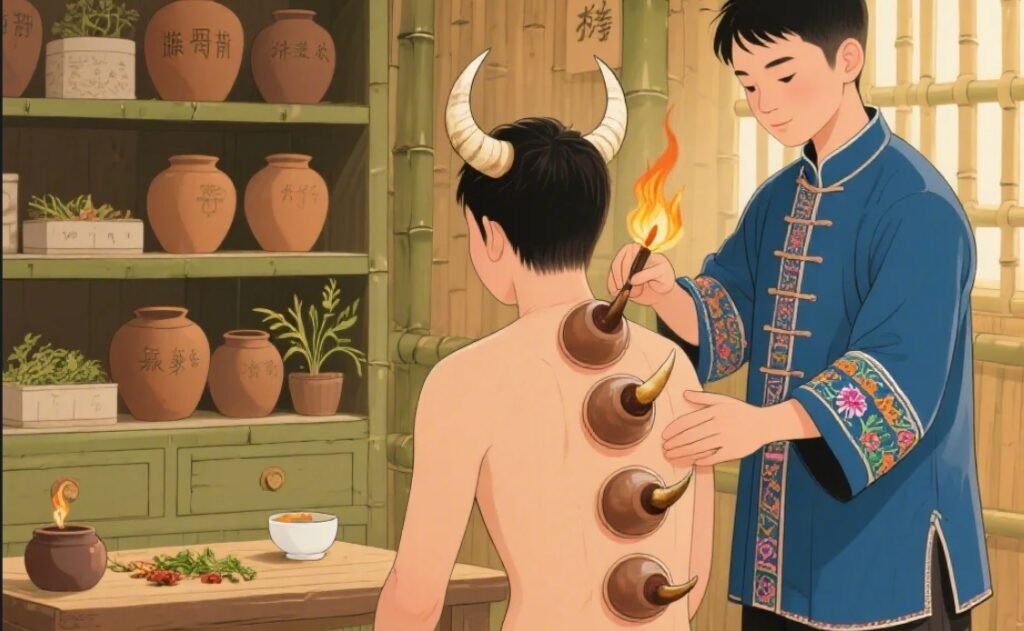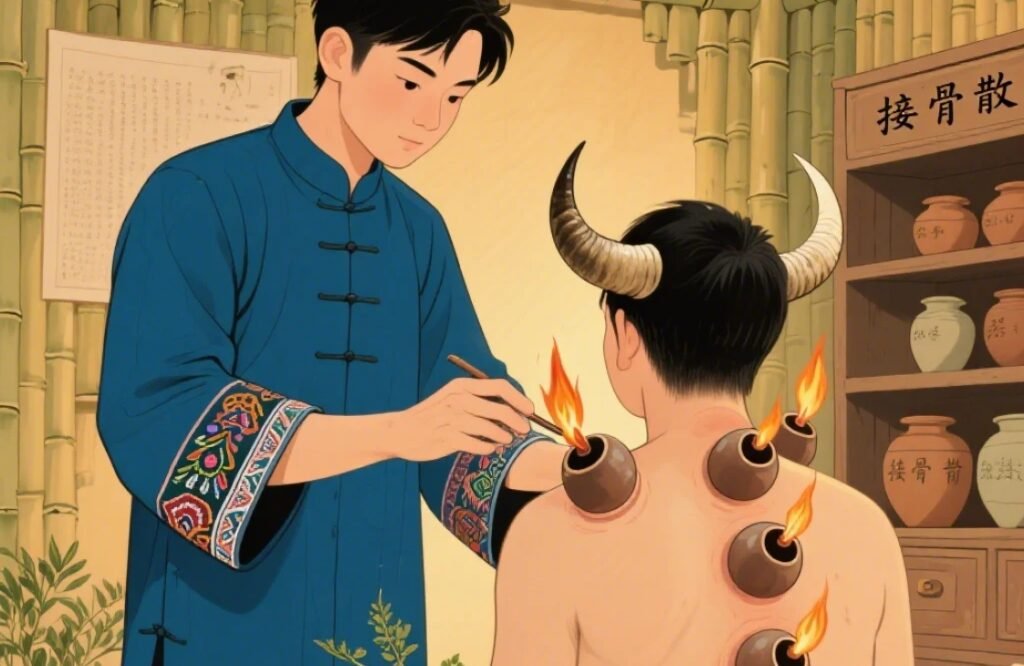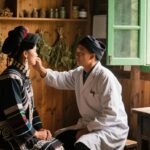Songruipao (Lung Abscess with Pus Formation)
Overview
In Miao medicine, lung abscess is called Songruipao. The disease course includes three stages: initial stage of lung abscess, lung abscess with swelling, and formation of pus in the lung abscess.
In Traditional Chinese Medicine (TCM), lung abscess refers to a syndrome in which toxic heat and blood stasis accumulate in the lungs, leading to ulceration, decay of blood and tissue, and formation of sores, clinically characterized by fever, chest pain, coughing with purulent, foul-smelling sputum, and in severe cases, expectoration of pus mixed with blood.
Lung abscess in TCM is generally equivalent to pulmonary abscess in Western medicine. Clinical presentations of suppurative pneumonia, pulmonary gangrene, bronchiectasis, or pulmonary tuberculosis with cavitation can also be treated with reference to this section.
Miao Medicine Disease Concept: Huhou Jipeng
The disease usually begins acutely, often with sudden chills or shivering, high fever (especially worse in the afternoon), cough, chest pain, and expectoration of thick purulent sputum. After around ten days, sputum volume increases and may appear like pus with a foul odor, sometimes mixed with blood. With the discharge of pus and blood, body temperature decreases and symptoms are relieved, leading to gradual recovery over several weeks. If toxins are not fully eliminated, chronic symptoms may develop with persistent cough, foul purulent sputum, low-grade fever, night sweats, and emaciation.
The disease progresses in three stages: onset of lung abscess, lung abscess with swelling, and pus formation.
Etiology: Aijiangduo
The condition is often caused by external wind-heat invading the lungs via the mouth, nose, or skin. Alternatively, habitual overconsumption of alcohol or spicy, greasy, and roasted foods can generate internal dampness, which transforms into phlegm and heat that smolders the lungs. Chronic retention of phlegm and heat in the lungs or phlegm-dampness and stasis from other organs rising to invade the lungs may also lead to abscess formation. If internal lung heat is already present and an external wind-heat invasion occurs, the combination is even more likely to cause this disease. Overwork and constitutional weakness reduce the body’s defenses, making it easier for external pathogens to invade.
Pathogenesis: Gengduomeng
The condition results from external evil invading the lungs, or from internal accumulation of phlegm-heat smoldering the lungs, causing heat-stasis and abscess formation, leading to decay of blood and tissue and formation of pus.

Diagnostic Key Points
1. Diagnostic Criteria
(1) History of external pathogen exposure or internal accumulation of phlegm-heat.
(2) Acute onset with sudden chills, high fever, cough, chest pain, and expectoration of large amounts of foul, purulent sputum, possibly mixed with blood.
(3) When sputum mixed with pus and blood is expectorated into water, pus sinks and phlegm floats; if eating raw soybeans or drinking raw soybean juice causes no awareness of foul taste, it indicates lung abscess.(4) Decreased breath sounds or moist rales on the affected side. In chronic cases, symptoms such as “purple and curved nails” and clubbing of the fingers may be present.
(5) Elevated white blood cell count and neutrophils in blood tests; X-rays may show dense inflammatory shadows, translucent zones, or fluid-air levels. Bronchography or fiberoptic bronchoscopy helps confirm Western diagnosis of lung abscess.
2. Relevant Examinations
Complete blood count, procalcitonin, ESR, C-reactive protein, biochemical panels, bronchography, fiberoptic bronchoscopy, and CT scan can all be used for preliminary screening.
Differential Diagnosis
Anwo – Exogenous Cough
Differentiating between Songruipao and Anwo is important. Both may begin with coughing and expectoration. However, Anwo is usually milder, whereas Songruipao tends to be more severe, with progressive increase in sputum, chills, high fever, and chest pain. Especially notable is the expectoration of large quantities of foul, purulent, and sometimes bloody sputum.
Classification and Treatment by Syndrome Differentiation
1. Initial Stage of Lung Abscess (Fenglepu·Kangmengkangbie)
Symptoms (Mengliduo): Chills, fever, cough, white sticky sputum gradually increasing in amount, chest pain worse with coughing, difficulty breathing, dry mouth and nasal passages.
Syndrome Type (Xingleng): Heat channel syndrome.
Treatment Principle (Jiahemeng):
Xukaitaji: Clear heat and resolve toxin
Weijiaoyangduxiang: Promote blood circulation and remove stasis
Danggou: Stop cough
Prescription (Ouduoxi Jia, Gangou):
Shidagonglao (Mahonia bealei, pan dou nai) 15g
Wild chrysanthemum flower (ye ju hua, bang wowo) 20g
White flower hogfennel root (bai hua qian hu, wo zu bie ba) 15g
Great burdock fruit (niu bang zi, xiang xue) 15g
Decoction for oral administration.
Each herb clears heat and toxins, resolves phlegm, and promotes lung function.

2. Lung Abscess with Swelling (Songruipao, Pubeng)
Symptoms (Mengliduo): High fever, chills, sweating, irritability, severe coughing, chest pain worsened by movement, expectoration of thick yellow-green foul sputum, dry mouth and throat.
Syndrome Type (Xingleng): Heat channel syndrome.
Treatment Principle (Jiahemeng):
Zhangdui Yang’an: Disperse stasis and reduce swelling
Prescription (Ouduoxi Jia, Fengou):
Viola yedoensis (zi hua di ding, wo hui ka na) 30g
Wild chrysanthemum flower (ye ju hua, bang wowo) 20g
Cynanchum bungei (bai ma gu, dou ye gei) 20g
Prunella vulgaris (xiaru cao, jia xing song) 30g
Bitter apricot seed (xing ren, zhen mang) 12g
Decoction for oral use.
The combination clears heat, detoxifies, and alleviates cough by dispersing swelling and resolving stagnation.
3. Suppuration Stage (Fengle Shan·Laji)
Symptoms (Mengliduo): Sudden expectoration of large volumes of blood-streaked purulent sputum (like rice congee), foul smell, chest fullness and pain, shortness of breath preventing lying flat, flushed face, fever, thirst with preference for drinking.
Syndrome Type (Xingleng): Heat channel syndrome.
Treatment Principle (Jiahemeng):
Xubutaji: Discharge pus and detoxify
Xukai Danggou: Clear heat and stop coughing
Prescription (Ouduoxi Jia, Gangou):
Japanese honeysuckle flower (jin yin hua, bang jia qiang) 30g
Patrinia herb (bai jiang cao, jia mei le) 20g
Chinese fevervine (senecio scandens, ou wu) 30g
Wax gourd root bark (dong gua gen pi, ling dou de) 20g
Gourd (gua, zhen hua xiu) 20g
Decoction for internal use.
These herbs combine to clear heat, detoxify, discharge pus, stop coughing, and unblock lung channels.
Preventive Care and Lifestyle Recommendations
Individuals with weak constitution or chronic illnesses should keep warm, maintain regular routines, and avoid pathogenic invasion. Early diagnosis and (used in traditional contexts) is crucial to (helps maintain) suppuration or lessen severity.
Diet should be light, favoring fruits and vegetables that moisten the lungs, generate fluids, and resolve phlegm, such as pears, loquats, radish, and water chestnut. Avoid salty, greasy, spicy, and seafood irritants like garlic, chili, leeks, and shrimp. Alcohol and smoking are strictly prohibited.
Maintain emotional balance and avoid excessive worry.
Commentary
In Miao medicine, Songruipao is mainly caused by external wind-heat entering the lungs via the mouth, nose, or skin; or from excessive consumption of alcohol and spicy grilled foods that generate dampness, phlegm, and heat, smoldering the lungs. Long-standing internal phlegm-heat or phlegm-damp stasis from other organs may ascend and invade the lungs, forming abscesses. When internal heat combines with external pathogens, the condition is more likely to develop. Overwork and weakened vital energy allow easier external invasion, making it a key internal factor. The disease course includes initial inflammation, abscess with swelling, and pus formation.
The core (used in traditional contexts) principles are to clear heat, resolve masses, detoxify, and discharge pus. Early stages require clearing the lungs and releasing exterior pathogens. Suppuration stages demand heat-clearing, toxin-resolving, and abscess-eliminating methods. Once pus forms, discharge becomes the top priority based on the principle “where there is pus, it must be drained.”


Leave a Reply